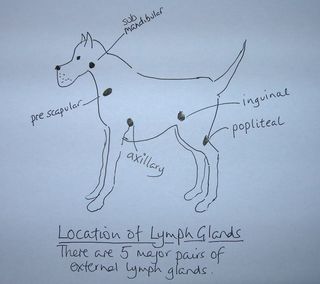Although it is not certain what causes it, one theory is that chemicals, including ant-parasite medication and household products may be one cause.
Signs to look for
The first sign is usually enlarged lymph nodes. Lymph nodes come in pairs and are located under the jaw, above the shoulder, in the arm pit and the groin. There are also internal nodes that you can’t see.

Maia’s first symptoms were enlarged nodes in the neck. They weren’t that big, but when I compared them to my other dogs, they were very obvious. Usually a dog’s lymph nodes are not obvious to the touch at all, you may have to dig around to find them, so if you can feel them easily then there is an infection or disease.
Now before you start panicking, there are many reasons why these nodes on either side of the neck may get enlarged, from a local infection – for example of the salivary glands or teeth – to things like tick-borne diseases such as Lyme disease.
However with lymphoma, these nodes stay enlarged and then others get enlarged too. However there may be no other sign at all that the dog is ill. Maia was absolutely 100% normal, playful and eating and drinking normally when I noticed the enlarged nodes.
What to do
The first thing to do is go to your vet. They may then do a blood test and take a needle aspiration of one or more nodes. This involves putting a needle into the lymph node and taking some sample cells which are then sent off for analysis. It appeared from Maia’s reaction, to be almost painless.
You will understandably be extremely anxious during the wait for the results, as it may take several days. All kinds of scenarios will play through your mind. I had prepared myself and done my crying by the time I got the results. They are looking for either B or T cells. Unfortunately, Maia had the most aggressive form of T cell lymphoma.
The vet will discuss treatment options with you. These are either chemotherapy, which dogs apparently tolerate much better than people do, or palliative treatment to relieve discomfort through steroids – usually prednisone (cortisone) – which can give a remarkable boost for two or three weeks. The dose is a tapered one and it is important to follow the instructions as stopping cortisone suddenly can have dire consequences on the adrenal system.
I put off the cortisone for as long as possible until Maia was starting to be very tired, refusing to eat and not at all herself, and then gave her a tapering dose as prescribed by the vet for almost four weeks. The initial effect was amazing, despite my fears of side effects. She was so much better, her old self really and started eating like a horse.
Although side effects of cortisone include thirst and peeing more, I can’t say I really noticed those. Loss of muscle tone is another side effect and I did start to notice that. All in all, I am glad we decided to give her the cortisone, although I was almost sick with apprehension beforehand. I think part of the problem also is that once you opt for cortisone you are really accepting that “this is it”. It took me a long time to accept it, but two consecutive days of Maia being ill put paid to all of that.
Lymph node staging
The vet will probably tell you what stage your dog is at. Mine didn’t so I just looked it up online. There are five stages:
Stage 1 – one lymph node/pair of nodes enlarged.
Stage 2 – lymph nodes enlarged on front or back half of body
Stage 3 – lymph nodes enlarged all over body
Stage 4 – internal involvement of liver/spleen
Stage 5 – other organs involved and/or bone marrow
I think Maia was probably at Stage 2/3 when I had her diagnosed and I didn’t really know when she had got to stage 4/5. All I knew was that she started having more difficulty breathing and that I could feel a hard longish mass in her abdomen. I also noticed one of her eyelids started showing and that she had a small reddish protrusion from under her tail which she licked a lot.
Life expectancy
This is shockingly short depending on whether or not you choose to give your dog chemotherapy, but with or without chemo, the prognosis is very sadly terminal. The average statistics are that with chemo the dog can go into remission and may live from six to 18 months more. A tiny percentage will achieve complete remission.
If the dog is not given chemo (we chose not to go that route with Maia) the life expectancy averages two months after diagnosis. Maia was diagnosed on July 2 and died on October 21, so she did very well.
Alternative treatments
As I am not a big fan of conventional medicine I immediately launched an internet search for alternative treatments for lymphoma.
One of the most interesting I came across was the Budwig Protocol, which involves a change in diet and giving a mix of cottage cheese and linseed oil. I did try this for a few weeks, but I was worried about Maia getting pancreatitis, which can be a side effect and needs to be carefully monitored. She loved the cottage cheese and oil mixture but I didn’t continue with it as it coincided with a day or so when she got quite sick and I wasn’t sure if the protocol could be the cause, so I stopped it.
Another interesting alternative treatment is Essiac tea which I ordered from Clouds Trust in the UK, getting the tea within a few days. It is a charity and they ask you to make a donation in exchange for a month’s supply. I bought the tea and all the equipment to make it but in the end I didn’t give it to Maia.
I found great help an comfort for her and me in doing simple massage and also healing. I imagined white healing light pouring into her body as I touched her gently. Rather than imagining negative things (eg “ go away cancer”) I thought positive thoughts like “your body is totally healthy, your immune system is strong” and so on. You can read more about pet healing in this interview I did with pet healer Margrit Coates.
When the time comes
You know your dog and you will know when it is time. I had several false alarms with Maia, but that last Saturday I took her to the vet and to my surprise he said she was OK but to bring her in again on Monday. I asked him what I should do if there was an emergency at 3 o’clock in the morning. As he was away at a conference for the weekend, he gave me the number of an emergency 24 hour vet in Arezzo.
Maia died in my arms at home at 3.30 am on Sunday morning.
I wish I had insisted he put her to sleep when I knew it was time. There is a saying “better a day too early than an hour too late.” I would agree with that. It is the last loving act you can do for your faithful friend and you must stay strong and calm even if you totally lose it afterwards. This is their time and you have to steel yourself to be as relaxed and soothing as possible. You can do it.
I comfort myself with the fact that Maia had a wonderful life for all but a couple of days. I grew even closer to her through her illness and I feel she is still here with me now. I learned a lot and have a lot to thank her for. Her life was too short but she was to me, as I wrote on her gravestone, “the best dog in the world.”


Thank you so much for writing about Maia. Our Francesca was recently diagnosed with lymphoma, but after just two chemotherapy treatments, which were extremely hard on her, we have decided to give her palliative care through our regular, and trusted, vets. We will live with the outcome. As my husband said, “Better two good months…or weeks…than a year of illness and poor quality of life.”
I agree with your husband, quality of life is everything. Maia had a good life and I a sure you will do all you can for your lovely Francesca.All good thoughts. x
Dear Fiona,
My dog, Sam, might have lymphoma. Her right front leg was suddenly swollen last Monday and then I soon found a very swollen lymp node just above her right shoulder. Today the vet did the needle aspiration and under the light microscope there were many large lymphocytes (the common sign of lymphocyte the vet said). The sample was sent for confirmation. She also has other lymph nodes swollen (both popliteal nodes and probably bilateral submandibular nodes too) and a “huge” spleen (found after ultrasound). According to your chart, she could be a stage 4. Other than that, there is no sign at all. Her blood resutls are absolutely normal. Her appetite is normal. Her energy level … well it is hard to tell… but seems normal or slightly lethargic (she came this way after her life-long canine friend died last year).
As just mentioned, I suddenly lost Frodo, my more-than-10-year-long canine companion, last year, due to the side effect of NSAIDs. This time… Sam. My heart is crying just at the thought of the test results confirming the orginal diagnosis. I agree that I should be strong and calm, as you wrote, to make a wise decision and provide a necessary support for Sam. But I cannot imagine my life without her. It was so hard to forgot the pain and loss of Frodo.
Thanks for writing this post. I can feel your pain, loss, sadness… and your love and strength.
-sooyoung.
Hi Sooyoung
I am so sorry about what you are going through. I hope Sam is OK.
Thank you for writing this and I’m glad Maia had so long as she did. I am currently happy to report Buford has been a great survivor after first being diagnosed in his butt. Now I’ve found one under his right armpit. I know he only has a little time left, but he’s living a high quality of life.
Hi Cindy
Thank you for your kind comment. I wish Bufort the very best.
Pingback: About Pets in Italy